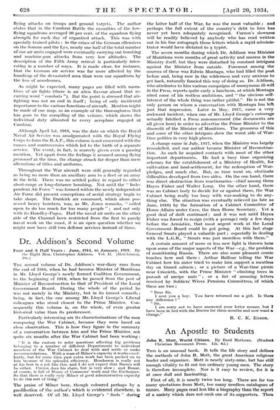Aerial Warfare
This volume of the official War history is in two sections; naval and military. The first part, which covers the period from January, 1917, to April, 1918, deals with the work of aircraft co-operating with the Fleet and on anti-submarine patrol in home waters, and with the diverse operations of the naval air squadrons based in the Dunkirk area. The remaining three-quarters of the book describes the air warfare on the Western Front from the Battle of Messines in June, 1917 to the end of the German offensive in April, 1918. The military chapters, in particular, contain a good deal of matter from German official sources which has been made available for the first time.
On the naval side, 1917 was noteworthy both for the intro- duction into the Fleet of land-planes, largely in place of float seaplanes, and for the development of the flying-boat into an effective patrol craft. Impressed by its growing efficiency, the Navy was discovering the Naval Air Service to be more of a help than a nuisance---a few months before the R.N.A.S. ceased to exist. The change in naval opinion is implicit in these pages. Other interesting points on which ample evidence is given are the failure of the German attacks by torpedo- carrying seaplanes on our shipping in coastal waters, and the relative success of the flying-boat as an anti-submarine weapon. Among the records of the flying-boat patrols are some of the most significant (and romantic) air episodes of the War. It seems a pity that more space could not have been given them : in preference, for instance, to the eight pages devoted to the death of von Richthofen in a later chapter. • - The military operations in France and Flanders are sketched in as a background—neither too dim nor too obtrusive—to the functions of the Flying Corps squadrons. Apart from the increase in the size of fighting formations, the chief feature of military air work in the period was the development of low- flying attacks on troops and ground targets. The author states that in the Cambrai Battle the casualties of the low- flying squadrons averaged 30. per cent. of the squadron flying strength for each day of organized attack. This was with specially trained pilots : in the crises of the German offensives on the Somme and the Lys, nearly one half of the total number of our air units engaged were eventually carrying out bombing and machine-gun attacks from very low altitudes. The description of the Fifth Army retreat is particularly inter- esting in a number of ways. It is made clear, for instance, that the German air service was far more affected by the handicap of the devastated area than were our squadrons by the loss of aerodromes.
As might be expected, many pages are filled with narra- tives of air fights (there is an alien flavour about that re- curring word " combats 41. But the point is stressed that air- fighting was not an end in itself ; being of only incidental importance to the various functions of aircraft. Mention might be made of one map, as an example of the thoroughness that has gone to the compiling of the volume, which shows the individual duty allocated to every aeroplane engaged at Cambrai.
Although April 1st, 1918, was the date on which the Royal Naval Air Service was amalgamated with the Royal Flying Corps to form the R.A.F., this volume is not concerned with the causes and controversies which led to the birth of a separate service. The event, in fact, is scarcely given even a passing mention. Yet apart from the feelings it aroused among flying personnel at the time, the change struck far deeper than mere alterations of titles and uniforms.
Throughout the War aircraft were still generally regarded as being no more than an ancillary arm to a fleet or an army in the field. There was no settled policy in regard to either short-range or long-distance bombing. Not until the " Inde- pendent Air Force " was formed within the newly independent Air Force did present conceptions of aerial strategy begin to take shape. The Dunkirk air command, which alone pos- sessed heavy bombers, was, as Mr. Jones remarks, " called upon to do too much for too many people " ; and not only with its Handley-Pages. Had the naval air units on the other side of the Channel been restricted from the first to purely naval work on the coast, it is an open question whether we might now have still two defence services instead of three.













































 Previous page
Previous page